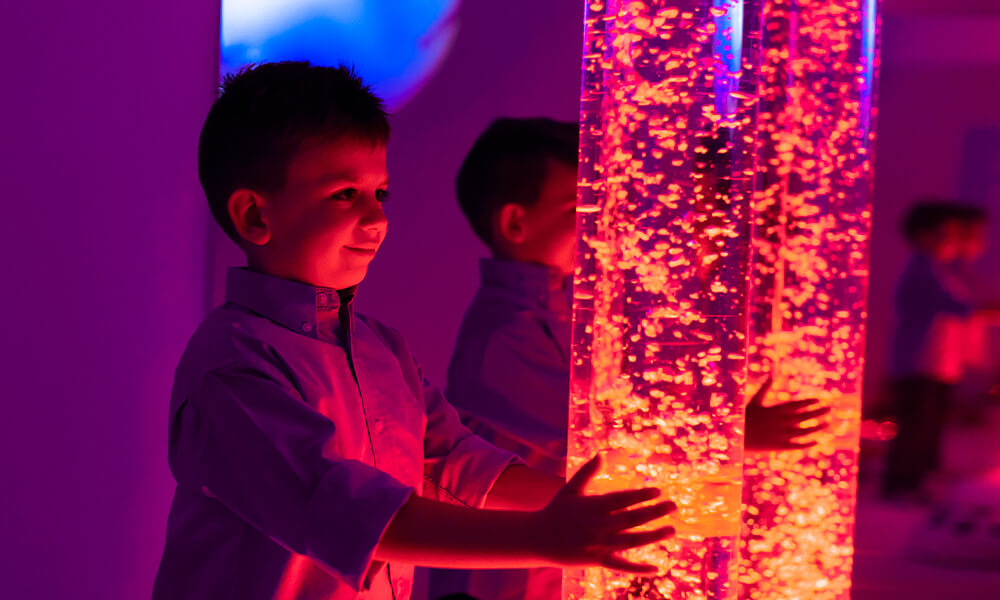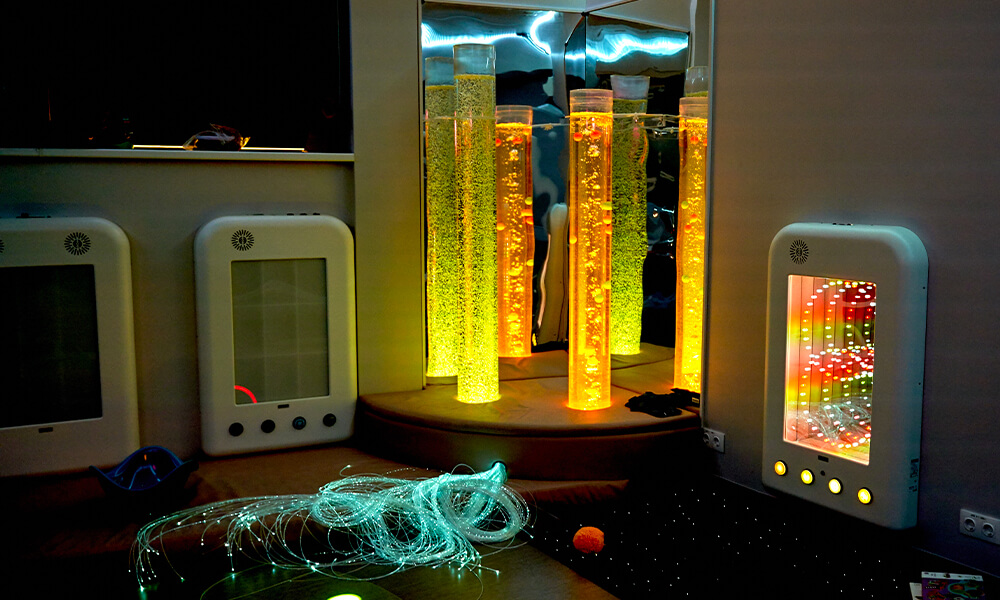Snoezelen, a unique therapeutic method, has garnered significant attention in recent years for its innovative approach to sensory stimulation and relaxation. This article delves into the origins of Snoezelen, its therapy and purpose, and the significance of the Snoezelen room in promoting relaxation and mental well-being.
What is Snoezelen?
Snoezelen, derived from the Dutch words ‘snuffelen’ (to sniff, explore) and ‘doezelen’ (to doze, snooze), is a form of non-directive, multi-sensory therapy aimed at stimulating the senses in a controlled environment. This therapeutic approach is designed to provide relaxation, sensory stimulation, and enhance cognitive function for individuals with various disabilities, including autism, dementia, and intellectual disabilities. The primary goal of Snoezelen is to offer a calming and enjoyable experience that improves the overall well-being of its participants.
Snoezelen therapy was developed in the Netherlands in the late 1970s by two Dutch therapists, Jan Hulsegge and Ad Verheul. They initially designed the method as a leisure activity for individuals with severe intellectual disabilities. However, over time, it gained recognition as a therapeutic approach, and its use expanded to other populations, including individuals with autism, dementia, and those experiencing high stress or anxiety.
What is Snoezelen Therapy?
Snoezelen therapy is a non-invasive, person-centered approach that uses a combination of visual, auditory, tactile, and olfactory stimuli to engage the senses. The therapy takes place in a specially designed Snoezelen room, where participants can freely explore and interact with the environment at their own pace.
Therapists and caregivers tailor the experience to the individual’s specific needs and preferences, ensuring that the environment is neither overstimulating nor underwhelming. Snoezelen therapy is not goal-oriented; instead, it focuses on the process of exploration and relaxation, encouraging participants to immerse themselves in the sensory experience.
Benefits of Snoezelen therapy include:
- Improved mood and relaxation: The calming atmosphere of the Snoezelen room helps to reduce anxiety, agitation, and stress, promoting overall relaxation and emotional well-being.
- Enhanced communication and socialization: Snoezelen therapy can help individuals with communication difficulties by providing alternative ways of expressing themselves and engaging with others.
- Stimulated cognitive function: The multi-sensory environment encourages exploration and interaction, which can help to enhance cognitive abilities and memory.
- Increased self-esteem and autonomy: Allowing participants to control their own sensory experience fosters a sense of independence and self-confidence.
The Snoezelen Room
The Snoezelen room is a unique, safe, and controlled environment designed to provide a soothing and stimulating experience for its users. Key elements of a Snoezelen room include:
- Lighting: Soft, diffused lighting, fiber optics, and LED lights create a calming atmosphere and help to reduce sensory overload.
- Sound: Ambient music or nature sounds play in the background, offering auditory stimulation and promoting relaxation.
- Aromatherapy: Essential oils and scents can be used to stimulate the olfactory senses and induce feelings of calmness.
- Tactile stimulation: Various textures, materials, and objects encourage participants to touch and explore, engaging their sense of touch.
- Visual elements: Bubble tubes, lava lamps, and projectors offer captivating visual stimulation, capturing participants’ attention and promoting relaxation.
Snoezelen Learning Materials
While Snoezelen is primarily a therapeutic approach rather than an educational method, the multi-sensory environment does offer various materials and tools that can stimulate learning and cognitive function in individuals. The emphasis is on creating a safe, enjoyable, and engaging space where participants can explore and interact with different sensory elements.
Some of the common Snoezelen learning materials include:
- Visual stimulation tools: These may consist of bubble tubes, lava lamps, projectors, and fiber optic lights, which captivate participants’ attention and encourage visual exploration.
- Tactile materials: Varied textures, soft toys, and touch-sensitive objects provide tactile stimulation and allow individuals to explore different sensations through touch.
- Auditory tools: Ambient music, nature sounds, and musical instruments can help stimulate auditory senses and promote relaxation, communication, and emotional expression.
- Olfactory materials: Aromatherapy oils and scents are used to engage the olfactory senses and induce a calming effect.
- Adaptive and interactive toys: These toys are designed to be accessible and engaging for individuals with varying abilities, encouraging exploration, problem-solving, and fine motor skills development.
Although the primary goal of Snoezelen therapy is to provide relaxation and sensory stimulation, the multi-sensory environment can also stimulate cognitive function, promote communication, and encourage socialization. In this sense, Snoezelen can be seen as a complementary approach to other educational methods, offering an alternative and supportive environment for individuals with various disabilities and conditions.
What are the differences and similarities with the Montessori method?
Montessori and Snoezelen are both unique approaches to education and therapy that share some common ground in their focus on the individual’s needs and preferences. However, there are some key differences between the two methods.
| Montessori | Snoezelen |
|---|---|
| Educational approach | Therapeutic approach |
| Focuses on self-directed, hands-on learning | Focuses on non-directive, multi-sensory stimulation |
| Develops cognitive, emotional, social, and physical skills | Primarily promotes relaxation, sensory stimulation, and cognitive function |
| Takes place in a prepared classroom environment | Takes place in a specially designed Snoezelen room |
| Targeted towards children in the educational setting | Targeted towards individuals with various disabilities and those experiencing high stress or anxiety |
| Goal-oriented (learning objectives) | Non-goal-oriented (process of exploration and relaxation) |
-
Montessori Method
Developed by Dr. Maria Montessori in the early 20th century, the Montessori method is an educational approach that emphasizes self-directed, hands-on learning in a prepared environment. Montessori education aims to foster the child’s natural curiosity and innate desire to learn. The approach focuses on developing the whole child, including cognitive and social development.
Key principles of the Montessori method include:
- Mixed-age classrooms: Children of different ages are grouped together, encouraging collaboration, mentorship, and social development.
- Child-directed learning: Children are given the freedom to choose their activities and work at their own pace, fostering independence and self-motivation.
- Prepared environment: Classrooms are meticulously organized, with hands-on materials designed to stimulate learning and facilitate mastery of concepts.
- Specially trained teachers: Montessori teachers are trained to observe, guide, and support each child’s learning journey, allowing them to follow their interests and progress at their own pace.
- Focus on developing the whole child: Montessori education emphasizes the development of cognitive, emotional, social, and physical skills, nurturing a well-rounded individual.
-
Snoezelen Method
As previously discussed, Snoezelen is a form of non-directive, multi-sensory therapy designed to provide relaxation, sensory stimulation, and enhance cognitive function for individuals with various disabilities. This therapeutic approach takes place in a specially designed Snoezelen room, where participants can freely explore and interact with the environment at their own pace.
Key principles of Snoezelen include:
- Non-directive therapy: Snoezelen therapy is not goal-oriented, focusing instead on the process of exploration and relaxation.
- Multi-sensory stimulation: The therapy uses a combination of visual, auditory, tactile, and olfactory stimuli to engage the senses.
- Person-centered approach: Therapists and caregivers tailor the sensory experience to the individual’s specific needs and preferences, ensuring an optimal environment.
- Safe and controlled environment: The Snoezelen room provides a unique, safe, and controlled environment for individuals to explore and interact with.
- Broad application: Snoezelen therapy is beneficial for individuals with various disabilities, including autism, dementia, and intellectual disabilities, as well as those experiencing high stress or anxiety.
Contraindications of the Snoezelen Method
While the Snoezelen method is a gentle and non-invasive form of therapy, there may be some instances where it may not be suitable or may need to be adapted for certain individuals. It is important to consider the specific needs and preferences of the participant before engaging in Snoezelen therapy.
Some potential contraindications or considerations for the Snoezelen method include:
-
Sensory sensitivities
For individuals with extreme sensory sensitivities, certain elements in the Snoezelen room may cause discomfort or anxiety. In these cases, the environment should be adjusted to accommodate the individual’s specific needs and preferences.
-
Medical conditions
Participants with certain medical conditions, such as epilepsy, may require additional considerations or adaptations to ensure their safety and comfort during therapy.
-
Behavioral concerns
Some individuals may exhibit challenging behaviors that could pose a risk to themselves or others in the Snoezelen room. In these situations, it is essential to address the underlying issues and provide appropriate support and supervision.
-
Inappropriate expectations
It is crucial to understand that the Snoezelen method is not a cure-all or a substitute for other necessary treatments and interventions. It should be viewed as a complementary approach to support the overall well-being of the individual.
Snoezelen Room Unique Features
A Snoezelen room is a specially designed environment that offers a soothing and stimulating experience for its users. It is characterized by its unique combination of sensory elements that engage the visual, auditory, tactile, and olfactory senses, promoting relaxation and well-being. This section highlights the particular features of a Snoezelen room.
-
Lighting
The room typically features soft, diffused lighting, fiber optics, and LED lights, which create a calming atmosphere and help to reduce sensory overload.
-
Sound
Ambient music or nature sounds play in the background, offering auditory stimulation and promoting relaxation. In some cases, soundproofing materials may be used to create a quieter environment if necessary.
-
Aromatherapy
Essential oils and scents can be used to stimulate the olfactory senses and induce feelings of calmness. Aromatherapy diffusers or scent machines may be incorporated into the room to provide a subtle and continuous fragrance.
-
Tactile stimulation
Various textures, materials, and objects encourage participants to touch and explore, engaging their sense of touch. Items such as textured panels, fidget toys, and soft cushions can be included in the room to offer a range of tactile experiences.
-
Visual elements
Captivating visual stimulation is provided through elements like bubble tubes, lava lamps, and projectors. These features can create an immersive and mesmerizing environment, promoting relaxation and focus.
-
Seating and relaxation areas
Comfortable seating, bean bags, or cushioned mats may be available for participants to relax and engage with the environment at their own pace.
-
Adaptability
The Snoezelen room should be easily adaptable to accommodate each individual’s unique needs and preferences. This may include adjustable lighting, volume controls for sound, and a selection of different tactile and visual elements.
-
Safety and accessibility
The room should be designed with safety and accessibility in mind, ensuring that the space is easy to navigate and free from potential hazards. This may include features such as padded floors, rounded corners, and wheelchair accessibility.





